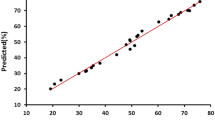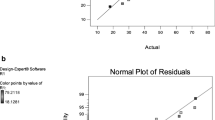Abstract
Nowadays, advanced oxidation processes (AOPs) are receiving increasing attention to be used for industrial wastewater treatment. In this study, the wastewater of Shazand Oil Refinery Company in Iran was treated using photo-Fenton method as a branch of AOPs. Box–Behnken design was used to reduce the number of tests and to conduct the statistical analysis of the results. The aim of this study was to reduce the chemical oxygen demand (COD) of industrial wastewater and obtain the optimum condition in the removal of COD. For this purpose, the effects of operating factors such as hydrogen peroxide concentration (10–30 mM), iron ion concentration (0.7–2.1 mM), and pH (2–6) were investigated. The results of the analysis of variance showed that the operating parameters were effective. The initial COD of industrial wastewater was about 3400 mg l−1, and in the achieved optimum conditions, approximately 75% of initial COD was removed and the amounts of other parameters such as biological oxygen demand (BOD), total organic carbon (TOC), and total dissolved solid were reduced significantly. The BOD5 to COD ratio of the treated wastewater was increased considerably. Moreover, the kinetic study revealed pseudo-first-order reactions for the removal of COD. Accordingly, as a figure of merit, the “electrical energy per order” was determined at 25.04 kWh m−3 order−1, showing low electrical energy consumption and high economical profit in comparison with high COD removal.






Similar content being viewed by others
References
Ahmadi M, Rahmani K, Rahmani A, Rahmani H (2017) Removal of benzotriazole by photo-Fenton like process using nano zero-valent iron&58; response surface methodology with a Box–Behnken design. Pol J Chem Technol 19(1):104–112
American Public Health Association, American Water Works Association, Water Pollution Control Federation, and Water Environment Federation (1915) Standard methods for the examination of water and wastewater, vol 2. American Public Health Association, Washington
Babuponnusami A, Muthukumar K (2014) A review on Fenton and improvements to the Fenton process for wastewater treatment. J Environ Chem Eng 2(1):557–572
Buyukada M (2016) Prediction of photo catalytic degradation and mineralization efficiencies of Basic Blue 3 using TiO2 by nonlinear modeling based on Box–Behnken design. Arab J Sci Eng 41:2631–2646
Çatalkaya EÇ, Şengül F (2006) Application of Box–Wilson experimental design method for the photodegradation of bakery’s yeast industry with UV/H2O2 and UV/H2O2/Fe (II) process. J Hazard Mater 128(2–3):201–207
Clarizia L, Russo D, Somma I Di, Marotta R, Andreozzi R (2017) Homogeneous photo-Fenton processes at near neutral pH: a review. Appl Catal B Environ 209:358–371
da Silva Leite L, de Souza Maselli B, de Aragão Umbuzeiro G, Nogueira RFP (2016) Monitoring ecotoxicity of disperse red 1 dye during photo-Fenton degradation. Chemosphere 148:511–517
Ebrahiem EE, Al-Maghrabi MN, Mobarki AR (2017) Removal of organic pollutants from industrial wastewater by applying photo-Fenton oxidation technology. Arab J Chem 10(2):1674–1679
El-sousy K, Hussen A, Hartani K, El Aila H (2007) Elimination of organic pollutants using supported catalysts with hydrogen peroxide. J J Chem 2(1):97–103
Funai DH, Didier F, Gimenez J, Esplugas S, Marco P, Junior AM (2017) Photo-Fenton treatment of valproate under UVC, UVA and simulated solar radiation. J Hazard Mater 323(A):537–549
Garcia-Segura S, Bellotindos LM, Yao-Hui H, Brillas E, Ming-Chun L (2016) Fluidized-bed Fenton process as alternative wastewater treatment technology—a review. J Taiwan Inst Chem Eng 67:211–225
Gareau BJ, Crow B (2006) Ken Conca, governing water: contentious transnational politics and global institution building. Int Environ Agreem Polit Law Econ 6(3):317–320
Gharbani P, Mehrizad A (2014) Heterogeneous catalytic ozonation process for removal of 4-chloro-2-nitrophenol from aqueous solutions. J Saudi Chem Soc 18(5):601–605
Huang YH, Huang YF, Chang PS, Chen CY (2008) Comparative study of oxidation of dye-Reactive Black B by different advanced oxidation processes: Fenton, electro-Fenton and photo-Fenton. J Hazard Mater 154(1–3):655–662
Mohadesi M, Shokri A (2017) Evaluation of Fenton and photo-Fenton processes for the removal of p-chloronitrobenzene in aqueous environment using Box–Behnken design method. Desalination Water Treat 81(1):199–208
Montgomery DC (2001) Design and analysis of experiments. Wiley, New York
Moon BH, Park YB, Park KH (2011) Fenton oxidation of Orange II by pre-reduction using nanoscale zero-valent iron. Desalination 268(1–3):249–252
Nitoi I, Oncescu T, Oancea P (2013) Mechanism and kinetic study for the degradation of lindane by photo-Fenton process. J Ind Eng Chem 19(1):305–309
Oki T, Kanae S (2006) Global hydrological cycles and world water resources. Science 313(5790):1068–1072
Peralta-Hernandez JM, Vijay S, Rodriguez-Narvaez O, Pacheco-Alvarez MA (2018) Chapter 9—photo and solar Fenton processes for wastewater treatment. In: Martínez-Huitle CA, Rodrigo MA, Scialdone O (eds) Electrochemical water and wastewater treatment, vol 9. Butterworth-Heinemann, Oxford, pp 223–237
Pera-Titus M, García-Molina V, Baños MA, Giménez J, Esplugas S (2004) Degradation of chlorophenols by means of advanced oxidation processes: a general review. Appl Catal B Environ 47(4):219–256
Rumky J, Ncibi MC, Burgos-Castillo RC, Deb A, Sillanpa M (2018) Optimization of integrated ultrasonic-Fenton system for metal removal and dewatering of anaerobically digested sludge by Box-Behnken design. Sci Total Environ 645:573–584
Saien J, Shahrezaei F (2012) Organic pollutants removal from petroleum refinery wastewater with nanotitania photo catalyst and UV light emission. Int J Photoenergy 2012:1–5
Saien J, Moradi V, Soleymani AR (2012) Investigation of a jet mixing photo-reactor device for rapid dye discoloration and aromatic degradation via UV/H2O2 process. Chem Eng J 183:135–140
Shokri A (2017a) A kinetic study and application of electro Fenton process for the remediation of the aqueous environment containing Toluene in a batch reactor. Russ J Appl Chem 90:452–457
Shokri A (2017b) Investigation of UV/H2O2 process for removal of Ortho-Toluidine from industrial wastewater by response surface methodology based on the central composite design. Desalination Water Treat 58:258–266
Shokri A, Mahanpoor K, Soodbar D (2016a) Degradation of Ortho-Toluidine in petrochemical wastewater by Ozonation, UV/O3, O3/H2O2 and UV/O3/H2O2 processes. Desalination Water Treat 57(35):16473–16482
Shokri A, Mahanpoor K, Soodbar D (2016b) Evaluation of a modified TiO2 (GO–B–TiO2) photo catalyst for degradation of 4-nitrophenol in petrochemical wastewater by response surface methodology based on the central composite design. J Environ Chem Eng 4:585–598
Trovo AG, Melo SAS, Nogueira RFP (2008) Photodegradation of the pharmaceuticals amoxicillin, bezafibrate and paracetamol by the photo-Fenton process—application to sewage treatment plant effluent. J Photochem Photobiol A Chem 198(2–3):215–220
Trovo AG, Hassan AK, Sillanpa M, Tang WZ (2016) Degradation of Acid Blue 161 by Fenton and photo-Fenton processes. Int J Environ Sci Technol 13:147–158
Zhu XD, Wang YJ, Sun RJ, Zhou DM (2013) Photocatalytic degradation of tetracycline in aqueous solution by nanosized TiO2. Chemosphere 92(8):925–932
Acknowledgements
The authors wish to thank the HSE Department of National Oil Refinery Company of Iran for technical guidance.
Author information
Authors and Affiliations
Corresponding author
Additional information
Editorial responsibility: M. Abbaspour.
Rights and permissions
About this article
Cite this article
Mohadesi, M., Shokri, A. Treatment of oil refinery wastewater by photo-Fenton process using Box–Behnken design method: kinetic study and energy consumption. Int. J. Environ. Sci. Technol. 16, 7349–7356 (2019). https://doi.org/10.1007/s13762-018-2153-5
Received:
Revised:
Accepted:
Published:
Issue Date:
DOI: https://doi.org/10.1007/s13762-018-2153-5




